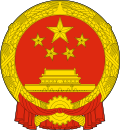Autonomous Region (China)
An autonomous region , AR for short ( Chinese 自治區 / 自治区 , Pinyin zìzhìqū ), also known as an autonomous region in the German-speaking area , is an administrative unit at the provincial level in the People's Republic of China . The system of national territorial autonomy is a fundamental part of Chinese state policy. Ethnic minorities live in the regions concerned and are granted special legislative rights under the Constitution of the People's Republic of China .
As in all Chinese provinces, an autonomous region has its own local government. The official title for the head of government is president , whereas in provinces without autonomous status it is governor . In the autonomous areas, the respective national minorities manage their internal affairs independently. Constitutional independence is guaranteed, among other things, in art, culture and science, in tax, social and other financial matters, in economic planning, the organization of the local police, the use of one's own languages.
There are a total of five autonomous areas in the People's Republic of China: Inner Mongolia was converted into an autonomous region in 1947 two years before the proclamation of the People's Republic in the area already controlled by the Chinese Communists , Xinjiang (Sinkiang) in 1955, Guangxi and Ningxia 1958 and Tibet 1965. All autonomous regions have existed as Chinese provinces since the Ming Dynasty ; some had their borders changed after the founding of the People's Republic of China.
Overview of the autonomous regions
| Surname | Abbreviation | Long characters | Pinyin | abbreviation | Capital | Area km² | population |
|---|---|---|---|---|---|---|---|
| Inner Mongolia | 内蒙古 | 内蒙古 | Nèi Měnggǔ | 蒙 měng | Hohhot | 1,218,698 | 24,706,321 |
| Guangxi | 广西 | 廣西 | Guǎngxī | 桂 guì | Nanning | 241.410 | 46,026,629 |
| Ningxia | 宁夏 | 寧夏 | Níngxià | 宁 níng | Yinchuan | 55,461 | 6,301,350 |
| Tibet | 西藏 | 西藏 | Xīzàng | 藏 zàng | Lhasa | 1,268,947 | 3,002,166 |
| Xinjiang | 新疆 | 新疆 | Xīnjiāng | 新 xīn | Urumqi | 1,774,034 | 21,813,334 |
All data according to the 2010 Census of the People's Republic of China.
Ethnic composition of the autonomous regions
| Autonomous Region | Proportion of primary minority | Proportion of Han living in the region | Third largest ethnic group |
|---|---|---|---|
| Inner Mongolia | 17.13% Mongols | 79.17% | 2.14% Manchu |
| Guangxi | 32.00% Zhuang | 62.00% | 3.00% Yao |
| Ningxia | 33.90% Hui | 65.50% | 1.16% Manchu |
| Tibet | 92.80% Tibetans | 6.10% | 0.35% Hui |
| Xinjiang | 45.21% Uyghurs | 40.58% | 6.74% Kazakhs |
All data according to the 2010 Census of the People's Republic of China.
See also
literature
- Ren Shuyin: China. Regional studies. Foreign Language Literature Publishing House, Beijing, 2001.
- Meyer's Atlas China: On the way to world power. Bibliographisches Institut AG, 2010.
- Yin Zhongqing: The political system in China today. China Intercontinental Press, 2004.
Individual evidence
- ^ A b Constitution Of The People's Republic Of US-China Institute, University of Southern California. In: china.usc.edu. December 4, 1982, accessed November 27, 2017 .
- ↑ Edgar Tomson; Jyun-hsyong Su: Government and Administration of the People's Republic of China . 1st edition. Verlag Wissenschaft und Politik, Cologne 1972, ISBN 3-8046-8448-3 , p. 383 .
- ↑ a b National Bureau of Statistics of China - 2011-04-29: National Bureau of Statistics of People's Republic of China on Major Figures of the 2010 Population Census. In: www.stats.gov.cn. Archived from the original on July 27, 2013 ; accessed on November 27, 2017 (Chinese, English).

